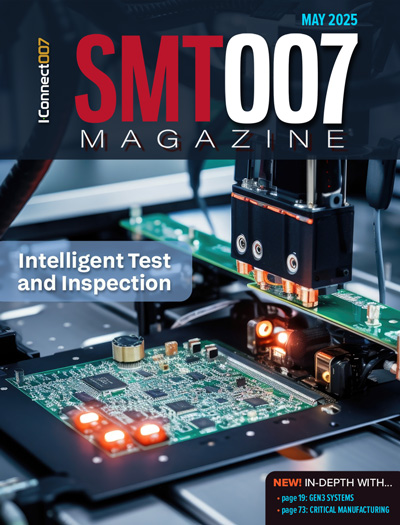-

-
News
News Highlights
- Books
Featured Books
- smt007 Magazine
Latest Issues
Current Issue
What's Your Sweet Spot?
Are you in a niche that’s growing or shrinking? Is it time to reassess and refocus? We spotlight companies thriving by redefining or reinforcing their niche. What are their insights?

Moving Forward With Confidence
In this issue, we focus on sales and quoting, workforce training, new IPC leadership in the U.S. and Canada, the effects of tariffs, CFX standards, and much more—all designed to provide perspective as you move through the cloud bank of today's shifting economic market.

Intelligent Test and Inspection
Are you ready to explore the cutting-edge advancements shaping the electronics manufacturing industry? The May 2025 issue of SMT007 Magazine is packed with insights, innovations, and expert perspectives that you won’t want to miss.
- Articles
- Columns
- Links
- Media kit
||| MENU - smt007 Magazine
Electronic Design Automation Market to Reach $17.47 Billion by 2030, Growing at a CAGR of 10.7%
March 31, 2025 | PRNewswireEstimated reading time: 4 minutes
According to a new market research report titled 'Electronic Design Automation Market Size, Share, Forecast & Trends Analysis by Offering (Solutions, Services), Deployment Mode (On-premise, Cloud-based), Tool Type (Design Tools, Verification Tools, Simulation Tools), and Geography – Global Forecast to 2030', published by Meticulous Research®, the global Electronic Design Automation (EDA) market is expected to grow from an estimated $8.96 billion in 2023 to $17.47 billion by 2030, at a CAGR of 10.7% during the forecast period.
Key Market Drivers and Trends
The growth of the EDA market is driven by the increasing complexity of integrated circuit (IC) designs, rising adoption of connected devices, and growing demand for EDA solutions in the aerospace and defense sectors. Additionally, the increasing integration of AI and machine learning in chip design is further boosting market expansion.
Cloud-based EDA solutions are gaining traction as companies seek cost-effective and scalable alternatives to traditional on-premise deployments. The ability to access design tools remotely, collaborate in real-time, and leverage cloud computing power is accelerating adoption across small and mid-sized enterprises (SMEs).
Growth Opportunities
The rapid evolution of AI and ML-based EDA tools is expected to create new growth opportunities. These advanced tools enhance automation, reduce design time, and improve performance, increasing efficiency in semiconductor and electronics manufacturing. Additionally, the growing demand for edge computing and high-performance computing (HPC) chips is driving the need for more sophisticated and automated EDA solutions.
The increasing adoption of cloud-based solutions is another major growth driver, enabling seamless collaboration and improved accessibility for global design teams. Companies are increasingly integrating AI and ML algorithms into their workflows to optimize design accuracy and efficiency, reducing costly errors and accelerating time-to-market. Moreover, the emergence of domain-specific electronic product designs and the rising focus on power-efficient chipsets for IoT and AI applications are expected to drive innovation in EDA solutions. Increased investments in R&D and strategic collaborations between semiconductor companies and EDA solution providers will further expand market potential.
Market Challenges
Despite strong growth potential, the EDA market faces several challenges. High software costs remain a major barrier, particularly for small and mid-sized companies looking to adopt advanced design tools. Licensing fees and maintenance costs can be substantial, limiting accessibility for smaller market players.
Another key challenge is the availability of open-source EDA tools, which, while cost-effective, lack the full-scale capabilities of premium solutions. As a result, companies must balance cost efficiency with performance when selecting EDA tools.
The rapid technological evolution of semiconductor manufacturing processes creates challenges in keeping EDA tools up to date. As chip designs become more complex, ensuring seamless compatibility between hardware and software tools is becoming increasingly difficult. Additionally, concerns regarding data security in cloud-based EDA deployments continue to hinder widespread adoption, especially in highly regulated industries like aerospace and defense. The industry also faces a shortage of skilled professionals with expertise in advanced EDA tools, further complicating adoption and implementation.
Segment Insights:
By Offering: The solutions segment dominates the market, accounting for approximately 72.4% of the share in 2023, driven by increasing investments in advanced IC design, verification, and semiconductor IP solutions. The services segment is anticipated to register the highest CAGR, as organizations seek expert consulting, training, and implementation support to enhance their EDA workflows.
By Deployment Mode: Cloud-based EDA solutions are expected to register the highest CAGR, with companies shifting towards flexible and cost-efficient design environments. Cloud-based deployment offers improved accessibility, real-time collaboration, and scalable computing power, making it an attractive choice for semiconductor manufacturers and electronics design firms.
By Tool Type: Design tools are the largest segment, accounting for 48.5% of the market share in 2023, due to growing complexity in ICs, printed circuit boards (PCBs), and semiconductor design processes. Verification tools are also seeing significant growth, driven by the increasing need to ensure chip reliability and performance before mass production.
Regional Analysis:
The Asia-Pacific region is expected to register the highest CAGR in the global electronic design automation market during the forecast period. The increasing presence of semiconductor foundries in China, Taiwan, South Korea, and Japan, coupled with rising investments in AI-driven chip design, is fueling market expansion in the region. Governments in these countries are also providing incentives to boost domestic semiconductor production, further driving demand for EDA solutions.
North America remains a dominant market due to the presence of major semiconductor manufacturers and EDA solution providers. The region's strong focus on R&D, coupled with high adoption rates of advanced design automation technologies, is sustaining steady growth. Europe is also witnessing a rise in EDA adoption, particularly in the automotive and aerospace industries, where the demand for high-performance and reliable chips is growing.
Competitive Insights
The global EDA market is highly competitive, with key players focusing on AI-powered solutions, strategic partnerships, and innovative product launches. Leading companies include Cadence Design Systems, Inc. (U.S.), Synopsys, Inc. (U.S.), Siemens AG (Germany), ANSYS, Inc. (U.S.), Keysight Technologies, Inc. (U.S.), Altium Limited (U.S.), Zuken (Japan), and Silvaco, Inc. (U.S.).
Recent Industry Developments
- March 2024: Cadence Design Systems launched an AI-driven chip optimization tool to improve design automation.
- January 2024: Synopsys acquired a semiconductor AI startup to enhance its ML-powered design verification tools.
- October 2023: Siemens EDA announced a partnership with a leading semiconductor foundry to streamline chip design processes.
Suggested Items
Prague PEDC: Call for Abstracts Deadline July 31
07/16/2025 | an-European Electronics Design Conference (PEDC)The second Pan-European Electronics Design Conference (PEDC) will take place Jan. 21-22, 2026, in Prague, Czech Republic. The call for abstracts deadline is July 31. Organized jointly by the German Electronics Design and Manufacturing Association (FED) and the Global Electronics Association PEDC serves as a European platform for knowledge exchange, networking, and innovation in electronics design and development.
Flexible Circuit Technologies Welcomes Regional Business Development Manager Derek Rossberg
07/15/2025 | Flexible Circuit TechnologiesFlexible Circuit Technologies a Minnesota-based flexible circuit and advanced electronics contract manufacturer, welcomes Derek Rossberg as Regional Business Development Manager.
Digital Twin Concept in Copper Electroplating Process Performance
07/11/2025 | Aga Franczak, Robrecht Belis, Elsyca N.V.PCB manufacturing involves transforming a design into a physical board while meeting specific requirements. Understanding these design specifications is crucial, as they directly impact the PCB's fabrication process, performance, and yield rate. One key design specification is copper thieving—the addition of “dummy” pads across the surface that are plated along with the features designed on the outer layers. The purpose of the process is to provide a uniform distribution of copper across the outer layers to make the plating current density and plating in the holes more uniform.
Meet the Author Podcast: Martyn Gaudion Unpacks the Secrets of High-Speed PCB Design
07/10/2025 | I-Connect007In this special Meet the Author episode of the On the Line with… podcast, Nolan Johnson sits down with Martyn Gaudion, signal integrity expert, managing director of Polar Instruments, and three-time author in I-Connect007’s popular The Printed Circuit Designer’s Guide to... series.
Showing Some Constraint: Design007 Magazine July 2025
07/10/2025 | I-Connect007 Editorial TeamA robust design constraint strategy balances dozens of electrical and manufacturing trade-offs. This month, we focus on design constraints—the requirements, challenges, and best practices for setting up the right constraint strategy.


